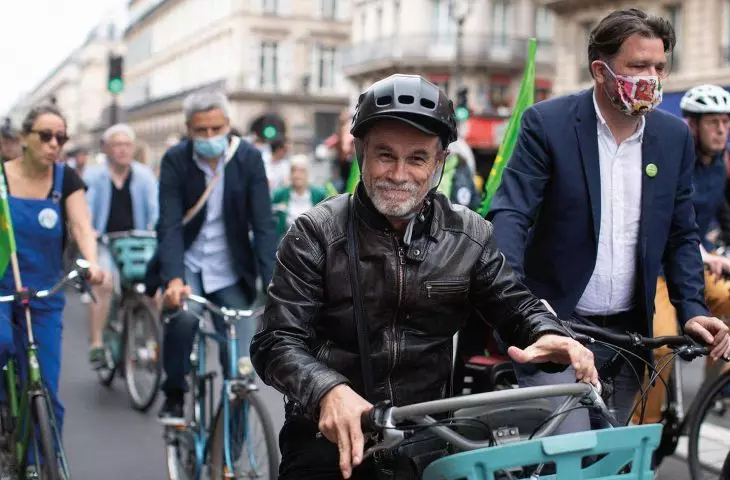Interview fromA&B issue03|2023
A conversation with Carlos Moreno, initiator of the concept of the fifteen-minute city, advisor to the Mayor of Paris, and academic director of the Entrepreneurship-Territory-Innovation Chair at the Sorbonne Business School in Paris.
Carlos MORENO - university professor, researcher. Expert on the cities and territories of tomorrow. The concept of the fifteen-minute city has earned him many awards and honors, including the Scroll of Honour from UN-Habitat or the OBEL Award. Committed to working for a better tomorrow for cities and the planet.
Photo credit: Thomas Baltes
Dominika Drozdowska: Can the idea of a fifteen-minute city be implemented in any city or neighborhood?
Carlos Moreno:The fif teen-minute city aims to address two universal challenges: climate change (through decarbonization) and human happiness (through lifestyle change). In fact, all cities and towns should ask themselves how they can change to meet these challenges. The urban planning model of the fifteen-minute city is based on polycentric planning, as a result of which residents can fulfill their daily needs by reaching them on foot or by bicycle within a quarter of an hour. We're talking about such needs as living and working, shopping, health care and education. Indeed, in some assumptions it is easier to develop the fifteen-minute city model, but I believe that all cities can work to enhance living close to one another and propose pleasant urban spaces that work for the benefit of residents. Like any idea or concept, the concept of a fifteen-minute city should be properly adapted to the area. That's why I developed the idea of a half-hour territory, because the density of suburban areas does not allow you to reach all services within a fifteen-minute walk. It's pretty obvious - it's a matter of working with the characteristics of a place to determine what "happy proximity" will be for that particular place.
Dominica:A lot of good things have been written and said about the fifteen-minute city. What are the flaws or weaknesses of this concept?
Carlos: As with any idea, there are issues that need to be improved or adapted to the situation. Certain practical aspects, such as city logistics, require functional and appropriate roads, similarly, the accessibility of housing for people with limited physical abilities. Another is the development of local commerce and spaces for social and community activities. These do not generate huge profits and therefore defy market logic, but their value is equally important. Still another issue is the functioning of suburbs, which take much longer than a quarter of an hour to get to. Here we get hooked on the real problem of spatial equality, which the concept of the fifteen-minute city may not solve by itself. Instead of the periphery of the center, we will have many new areas with the character of a center, each of which will have room for many activities.
In the fifteen-minute city model, residents can carry out their daily needs by reaching them on foot or by bicycle within a quarter of an hour
pic: Micaël
Dominica:Under what circumstances will a fifteen-minute city not work?
Carlos: The first issue in this concept is the transportation revolution. Therefore, the idea will not work in a city that does not want to change its mobility. If 100 percent of cars still remain in the space, it will not be possible to free up space for other purposes - for pedestrians and bicycles. Going further, if 100 percent of parking spaces are left - it will not be possible to make room for wider, greener sidewalks, child-safe city promenades or gardens for restaurants. If 100 percent of cars remain in the city space, there will still be traffic jams and polluted air. Daily distances to be traveled will still be considerable, and the rhythm of urban life will not be calmed down, casual neighborhood gatherings will not be possible. Public transportation and space for active mobility are therefore essential for the fifteen-minute city.
Dominika:In Poland - for various reasons - we are seeing a process of urban sprawl. Among other things, economic reasons encourage Poles to live in the suburbs and commute to work every day in their own cars, because public transportation does not work. I wonder if the idea of a fifteen-minute city could apply to this problem.
Carlos: To be honest, this concept was born precisely from the observation that city and suburban residents waste too much time, energy and happiness every day on long trips. This question raises two interesting points. First, the efficiency of public transportation is essential to the decarbonization of cities. The network and its frequency must be improved to encourage residents to use public transportation. Similarly, price - should not be a barrier. Public investment in the transportation network is therefore a prerequisite. Second, if the distance between home and work cannot be reduced, "living nearby" becomes complicated. With digitization, modes and workplaces are changing. For suburban residents, one can imagine different modes of work adapted to the industry, for example, flexible working hours, co-working, office relocation or remote working. The concept of the fifteen-minute city is forward-looking and proposes the evolution of urban environments in parallel with the evolution of society.
Dominica:Continuing with the issue of pre- and downtowns, how do you reconnect the two?
Carlos: Only well-functioning public transportation and bicycle paths connecting the inner city with other neighborhoods and suburbs can address this need. Let's remember, however, that the goal of the 15-minute city is not to gather residents in its center, but to offer every resident a happy life near where they live. So it might be interesting to turn the question around: how can a residential neighborhood be improved to offer residents what they come to the city center for? What does it lack and how can it be enriched? What types of services or public spaces do residents need?
Dominica:Could you say more about where the idea for the fifteen-minute city came from?
Carlos: It's the result of work that began in the early 2000s. Through my experience in researching and reflecting on IT complex systems, I then began to question the functioning of the city. In 2010, the concept of the "technical", "cold" and "smart" city began to dominate. This motivated me to develop a model that is anchored in modernity, but not through technology, but through sustainability and humanity. Now the concept is gaining international traction, so I'm working on implementing it in various places around the world.
Dominika:Exactly - I assume that the idea itself is only part of the success. The other is multiple presentations so that the concept can break through to a wider audience. Aren't you sometimes tired of these activities?
Carlos:Of course, it takes a lot of work, time and energy. However, I consider it part of my responsibilities. Changing our urban lifestyle is essential to avoid collapse and the death of the planet. In addition, meetings, discussions and presentations allow the concept of the fifteen-minute city to evolve and grow. I'm happy to be able to speak on an issue that I'm passionate about and, I hope, can have a positive impact on the lives of individuals and the planet.
fifteen-minute Paris
pic: Micaël
Dominica:Probably the best-known realization of the fifteen-minute city is Paris. Its mayor, Anne Hidalgo, adopted the tenets of this concept for her re-election program. Do you know of any other interesting examples?
Carlos:Several cities from different parts of the world are applying the concept of a city based on proximity and short distances, such as Canada's Ottawa with its transformation plan until 2046 (The New Official Plan) or Australia's Melbourne with a plan stretching from 2017 to 2050 and a strategy based on "Local Life - Twenty-Minute Neighborhoods." Although not called a fifteen-minute city, Spain's Barcelona has created its own "Superblocks" strategy based on proximity. "Urban blocks" measuring 400 meters by 400 meters are changing the world of urban form by creating new city centers, thus a polycentric city. It is part of an urban system adapted to the scale of a person, not a car. It's an innovative approach to planning that responds to the challenges of mobility (no cars, promoting active mobility), public space (freeing up 92 percent of such space), biodiversity and social cohesion. It's also a participatory program that involves residents and local organizations. In addition, the C40 Global Network of Cities for Climate at the start of the COVD-19 pandemic in 2020 has adopted the concept of the fifteen-minute city. This is a powerful network of nearly a hundred cities representing 900 million people. UN-Habitat is also recommending the development of this concept, as is the Federation of United Cities and Local Governments (UCLG). It is a global movement that grew out of this concept. For the first time, the European Union announced a call for projects on the 15-minute city with the September 2022 Driving Urban Transitions program. In addition, my team has formed a consortium that includes the small Polish city of Pleszew, which is leading the implementation of the concept.
Dominik:You travel a lot and know a lot of cities around the world. Which one is your favorite or could become your city of residence?
Carlos: This question, which I hear quite often, leads me to conclude that there is no perfect city. Our planet is vast and diverse, offering cities set in different contexts, but equally fascinating. The charm of Mediterranean cities, including Italy's "la dolce vita," the good quality of life of Northern European cities, the grace of Central European cities that are old, though scarred by the actions of World War II, the beauty of Asian cities, the warmth of Latin American cities, or the vitality of African cities... A former mayor of Denver in the United States said that the 19th century was the century of empires, the 20th century was the century of nation-states, and the 21st century will be the century of cities. I agree with this statement. Cities are our places to live, and it is up to us to shape them to bring them closer to the human scale. It is up to us to decide how we want to live. And whether the places we leave to the next generation are full of joy and prosperity, harmony with nature and biodiversity and, quite simply, the good life.
Dominica:Thank you for the interview.























